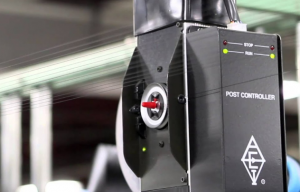
Karl Mayer acquires YTC yarn tensioner technology
28 June 2010, Shanghai - Karl Mayer’s successful policy for its warp knitting machines is based on lightweight component construction and a twin product line strategy, an arrangement that is specifically designed to meet the requirements of the market. Its machines equipped with CFRP (carbon-fibre-reinforced plastic) components offer a unique performance profile and in addition the strategy of making both basic as well as high-tech machines available gives the company greater access to a bro
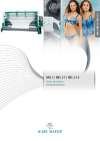
28th June 2010
Knitting Industry
|
28 June 2010, Shanghai - Karl Mayer’s successful policy for its warp knitting machines is based on lightweight component construction and a twin product line strategy, an arrangement that is specifically designed to meet the requirements of the market. Its machines equipped with CFRP (carbon-fibre-reinforced plastic) components offer a unique performance profile and in addition the strategy of making both basic as well as high-tech machines available gives the company greater access to a broader client base.
The results of Karl Mayer’s policy to constantly optimise its products were on show at ITMA ASIA+CITME 2010, where the company exhibited the first raschel machine equipped with CFRP components and a high-speed tricot machine, which is already benefiting from the advantages of its 2nd generation of CFRP technology. Other highlights on Karl Mayer’s stand were a machine in the Seamless Smart range and a JL 59/1B, both in finer gauges, as well as the KAMCOS Explorer for production planning and control.
Meanwhile, the latest innovations in double-bar raschel machines were also on display at an in-house show held at Karl Mayer’s subsidiary in Wujin in the run-up to the exhibition and also during the exhibition itself. The event was held from 16 to 21 June and, as well as showing a new, basic HighDistance machine, Karl Mayer also showed the new RD 6/1-12.
Knitting Industry spoke to Karl Mayer’s Oliver Mathews at ITMA Asia + CITME in Shanghai, who talked us through the company’s latest offering.
Higher speed and finer gauge for Jacquardtronic Lace
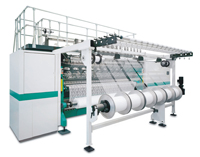 In keeping with the trend towards finer fabrics, Karl Mayer presented
a JL 59/1B in a new gauge of E28. Previously the finest gauge was E24.
The Jacquardtronic Lace machine was sequentially producing transverse lace,
conventional ribbons and full-width fabrics, each featuring its own, unique
filigree design. By operating in sequential mode, the versatile production
machine was showing the range of fine, contrasting patterns that can be
produced in this new fine gauge and on transverse lace in particular.
In keeping with the trend towards finer fabrics, Karl Mayer presented
a JL 59/1B in a new gauge of E28. Previously the finest gauge was E24.
The Jacquardtronic Lace machine was sequentially producing transverse lace,
conventional ribbons and full-width fabrics, each featuring its own, unique
filigree design. By operating in sequential mode, the versatile production
machine was showing the range of fine, contrasting patterns that can be
produced in this new fine gauge and on transverse lace in particular.
The lace fabrics that were being produced during the exhibition were patterned in an attractive combination of a delicate mesh ground and dense floral designs. The machine was operating at 28 stitches/cm (56 stitches/cm in the finished fabric) to produce the fine net zones on the transverse lace and at 24 stitches/cm (42 stitches/cm in the final fabric) in the floral patterns.
“The yarn run-ins of ground guide bar GB 1 and jacquard bars JB 59-60 were adapted to the sequential take-off values. The stability of the mesh structure, which is an important quality aspect of the fabric and affects the resilience of the lace, is higher than with conventional fabrics because of the high stitch number in the net section,” Oliver Mathews said. Visitors to Karl Mayer’s stand were also said to be impressed by the high operating speed and flexibility of the JL 59/1B.
“The Jacquardtronic Lace has a working width of 132 inches which can be extended to 134 inches and can reach speeds of up to 850 rpm. The JL 59/1B has eight strings in the individual shog lines instead of six, like its counterpart the JL 42/1 and can produce a wide range of different patterns using a variety of different yarns,” added Mr Mathews.
Fine gauge seamless
In the Seamless Smart sector, the DJ 4/2 EL was producing complete garments in the brand new gauge of E 32. Oliver Mathews commented: “The DJ 4/2 EL has a working width of just 44 inches and with its high speed and exceptional flexibility, this compact machine has a list of performance features that makes it ideal for companies new to this sector, as well as those needing to produce a large number of patterns and sample. Small runs can be produced just as efficiently as large batches and intricate pattern samples.”
Alongside the running machine was a range of new samples which showed the type of garments, lingerie and sportswear that can be produced. The DJ 4/2 EL was producing a new type of shape leggings in gauge E32 during the show and achieved a production rate of 750 courses per minute.
As well as the new gauge of E 32, single tension fingers at the yarn guide elements are also a feature of the DJ 4/2 EL (DJ 6/2 EL). The single tension fingers are used to equalise any tension differences in the jacquard yarns when using non-stretch yarns. If single tension fingers are not used, expensive two-component yarns (e.g. core yarns) have to be used when producing many garments, a restriction which makes the product more expensive and limits the lapping and patterning possibilities, Karl Mayer says.
First raschel machine with CFRP components
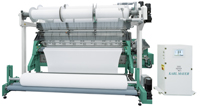 The new RSE 4-1 is the first machine in its series
to feature Karl Mayer’s ‘lightweight’ technology. The package of optimised
features includes the use of CFRP components in all the bars, and solutions for
improving the stability to lateral distortion in the needle zone. Karl Mayer
says the basic design as well as specific details of the machine were also
adapted to suit the higher dynamics.
The new RSE 4-1 is the first machine in its series
to feature Karl Mayer’s ‘lightweight’ technology. The package of optimised
features includes the use of CFRP components in all the bars, and solutions for
improving the stability to lateral distortion in the needle zone. Karl Mayer
says the basic design as well as specific details of the machine were also
adapted to suit the higher dynamics.
According to Oliver Mathews, Karl Mayer has already sold a few RSE 4-1 machines incorporating the lightweight technology and the customers are benefitting from the technology: “The result of changing the RSE 4-1 to incorporate these lightweight, stable, fibre-reinforced plastic components is that the temperature window for reliable, trouble-free operation has been extended from +/- 2°C to +/- 7°C, and the weight of the bars has been reduced by as much as 25%, which has resulted in higher productivity, “ said Mr Mathews.
Throughout the exhibition, the RSE 4-1 (170 inch, E 32) with its high speed of up to 2600 rpm is said to have caused quite a stir.
High-speed tricot machines with 2nd generation CFRP technology
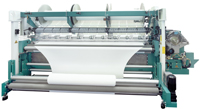 By the end of last year, Karl Mayer’s HKS range of machines
had largely been switched to CFRP components. The company says that subsequent
optimisation work will focus on segmenting the shaft for controlling the bars.
This component used to be produced from a single piece and had to be heated
continuously to guarantee reliable operation even at high speeds. The high-precision
segments are virtually dimensionally stable, without the need to apply heat
externally, Karl Mayer says.
By the end of last year, Karl Mayer’s HKS range of machines
had largely been switched to CFRP components. The company says that subsequent
optimisation work will focus on segmenting the shaft for controlling the bars.
This component used to be produced from a single piece and had to be heated
continuously to guarantee reliable operation even at high speeds. The high-precision
segments are virtually dimensionally stable, without the need to apply heat
externally, Karl Mayer says.
According to Karl Mayer, when arranged in a row for use as the shaft, they guarantee rapid start-up times and a high gauge accuracy, even at fluctuating ambient temperatures. This enables even fine fabrics to be produced in high quality at wide working widths and high speeds, such as was demonstrated by the HKS 2-3 E in E 36 equipped with 2nd generation of CFRP technology at the show.
The high-tech machine was operating at speeds of up to 3600 rpm. The basic machine has a working width of 180 inches but, as an option, this can be extended to 186 inches to cater for the growing trend for fabrics in wider widths. Previously, the HKS 2-3 E was only available in widths of up to 130 inches. The final width of fabrics produced on the new HKS 2-3 E can be as much as 40% higher, Karl Mayer says.
HighDistance - HD 6/20-35
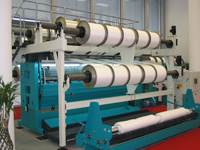 Karl Mayer has now extended its successful twin product line
strategy to encompass its double-bar raschel machines and developed a basic
version of the HighDistance machine to coincide with the opening of ITMA
ASIA+CITME.
Karl Mayer has now extended its successful twin product line
strategy to encompass its double-bar raschel machines and developed a basic
version of the HighDistance machine to coincide with the opening of ITMA
ASIA+CITME.
The new machine is known as the HD 6/20-35 and was unveiled for the first time at an in-house show held at Karl Mayer(China) Ltd. in the run-up to ITMA ASIA+CITME 2010, where it is said to have impressed visitors with its performance features which Karl Mayer says are perfectly suited to the market.
The HD 6/20-35 (110 inch, E 12) can reach a maximum productivity of 600 courses per minute and the distance between the trick plates can be adjusted from 20mm to 35mm. The result, Karl Mayer says, is a new range of spacer textiles that is particularly suitable for use in mattresses and car seats.
“The HD 6/20-35 also offers Karl Mayer’stried-and-tested technology, such as the KAMCOS computer system, Motion Control and Single Speed functions, Laserstop yarn monitoring system, and electronically controlled yarn feeding. With its specific technology for moving the guide bars, the HighDistance is a practical and cost-effective machine,” said Oliver Mathews.
“The patented systems, which have already been used on the high-end version of the HighDistance machine, guarantee that the pile bars on this new machine also operate in counter notation mode over the entire distance between the trick plates without any problems. This enables an IXI lapping to be worked here as well, which gives the spacer textile the required stability.”
“The HD 6/20-35, with its high level of productivity, is geared up to what is needed rather than what is possible, and offers rapid amortisation times. Under normal, i.e. average, production conditions, the investment in a new machine will be recouped in about two years, which is an important aspect, especially for manufacturers in search of new business opportunities,” added Mr Mathews.
RD 6/1-12 high-speed machine
 Spacer textiles with a small gap between the cover faces are
the best-sellers among the spacer textiles, which makes the market for these
textiles particularly competitive. Karl Mayerhas therefore developed a new
production machine with an extremely competitive cost:performance ratio in
order to give its customers the edge over their competitors. The new machine is
known as the RD 6/1-12, and it was exhibited at the in-house show in
Wujin where it is said to have generated a great deal of interest.
Spacer textiles with a small gap between the cover faces are
the best-sellers among the spacer textiles, which makes the market for these
textiles particularly competitive. Karl Mayerhas therefore developed a new
production machine with an extremely competitive cost:performance ratio in
order to give its customers the edge over their competitors. The new machine is
known as the RD 6/1-12, and it was exhibited at the in-house show in
Wujin where it is said to have generated a great deal of interest.
Oliver Mathews explained: “Everyone was talking about the new machine’s unique speed and all the visitors were keen to get a closer look at it. This high-speed machine can reach a maximum operating speed of 475 rpm or 950 courses per minute. This accurate, reliable double-bar raschel machine is also extremely flexible in terms of the range of designs it can produce.”
The technical details of the new, double-bar raschel machine are as follows: a working width of 138 inches, available gauges of E 18, E 22 and E 24, optimum yarn monitoring using the Laserstop system, KAMCOS system with Motion Control/Single Speed functions and the possibility of setting the space between the trick plates in a range of 1 to 12 mm.
KAMCOS Explorer
Alongside its new warp knitting machines, Karl Mayer was also showing the features of its KAMCOS system and the focal point of its presentation was the new KAMCOS Explorer system. The machines were networked to each other and to a typical factory type workstation in order to demonstrate how easy it is to process information using the system. Visitors were able to view directly into the machines from this point and by using the tried-and-tested Windows menu-driven system similar to the KAMCOS Operator Interface, all the machine data was displayed on the laptop, from the machine set-up in the production hall, through detailed information relating to the shift and piece data, to memos that can be input using free text.
The operating data can be printed out either using a printer linked to a PC or a networked printer at the machine for documentation and recording purposes. The networked printers can also be used to produce a hard copy of the various relevant items of information, such as fault records or current beam data, directly from the operator’s console. The Teleservice system was also being demonstrated on a laptop during the exhibition.

Business intelligence for the fibre, textiles and apparel industries: technologies, innovations, markets, investments, trade policy, sourcing, strategy...
Find out more